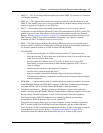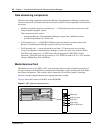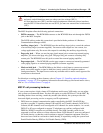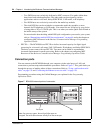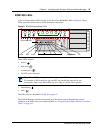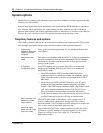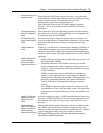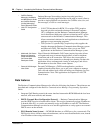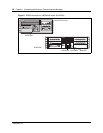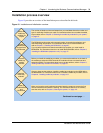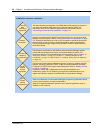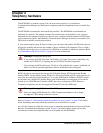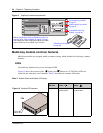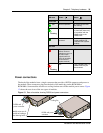
Chapter 1 Introducing the Business Communications Manager 29
Installation and Maintenance Guide
• IP Routing — Business Communciations Manager software supports the following IP routing
protocols:
— static routing
— RIP (Routing Information Protocol)
— OSPF (Open Shortest Path First)
• IPX Routing — Business Communications Manager supports the following IPX Routing
protocols in a NetWare environment:
— static routing
— RIP (Routing Information Protocol)
— SAP (Service Advertising Protocol)
• NAT (Network Address Translation) — Business Communications Manager supports both
static and dynamic NAT for a number of packet types and protocols. NAT is a network
security feature that translates the IP addresses used within your private network to different IP
addresses known to internet users outside your private network.
• Policy Management — Business Communications Manager allows you to implement classes
of service and assign priority levels to different types of traffic using the DiffServ network
architecture. You can configure policies that monitor the characteristics of traffic, for example,
its source, destination, and protocol, and perform a controlling action on the traffic when
certain user-defined characteristics are matched.
• VPN (Virtual Private Networks) — Business Communications Manager uses the PPTP
(point to point tunneling protocol) and IPSec (IP security) tunneling protocols to create secure
extranets. These secure extranets provide safe transport of data to and from the Business
Communications Manager using the public data network (PDN).
Business Communications Manager expansion unit
The BCM1000e houses a maximum of six additional media bay modules. The cable that comes
with the expansion unit connects into a DS256 port on the MSC of the BCM1000, and into a
DS256 port on the center panel of the BCM1000e. Refer to Figure 9.
This cable, called a Category 5, DS256 or RJ45 cable, must be 5 m (16 ft.) long.
Note: The number of modules that actually can be installed is determined by the number
of DS30 channels required by the modules and the number of channels available.
Refer to Chapter 5, “Installing the BCM1000,” on page 67.



